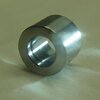westernrover
Member
- Joined
- May 4, 2018
- Messages
- 1,613
I suppose that brass fired in my chamber fits tightly compared to factory-new brass or loaded cartridges that must fit in a SAAMI minimum-dimension chamber. This tighter fit should result in less movement of the brass during firing and more consistent/accurate results. However, I must resize the brass at least some if I am to expect it to chamber reliably.
I could practice neck-only resizing, though I understand that has fallen out of favor to the point of being mocked and ridiculed. Instead, I have used a Redding body die to bump the shoulder. I don't bump by the thou, but so that the bolt handle (with the spring removed) drops on all cases without resistance. In my experience, this has required bumping most cases a couple thou so that there are no cases that aren't bumped enough. As long as I am using a bolt gun, I will check with that. For a semi-automatic, I suppose I would have to bump 2 or 3 thou to ensure all the cases would chamber without issue.
I recently bought a full-length bushing type sizing die (for a cartridge different than any I previously loaded). I am lacking a comparator insert for the case (out of stock), so I haven't been able to adjust the die precisely yet. What I've noticed is that the body diameter is being resized back to factory cartridge dimensions. This means it's going to fit loosely in the chamber, except for the headspace against the neck which I will be able to control when I'm able to set the bump.
Should I hone the full-length sizing die out so the brass is squeezed down less and fits more tightly? Or is just bumping the shoulder no more than necessary sufficient to achieve a fit in the chamber that will provide the best accuracy?
If my un-honed die is going to resize the body to a loose fit, and only the shoulder will be fit to my rifle's chamber, do I really need brass fired in my chamber to make accurate loads, or can I just use brass fired in any chamber so long as I can set the shoulder datum to some spec?
I could practice neck-only resizing, though I understand that has fallen out of favor to the point of being mocked and ridiculed. Instead, I have used a Redding body die to bump the shoulder. I don't bump by the thou, but so that the bolt handle (with the spring removed) drops on all cases without resistance. In my experience, this has required bumping most cases a couple thou so that there are no cases that aren't bumped enough. As long as I am using a bolt gun, I will check with that. For a semi-automatic, I suppose I would have to bump 2 or 3 thou to ensure all the cases would chamber without issue.
I recently bought a full-length bushing type sizing die (for a cartridge different than any I previously loaded). I am lacking a comparator insert for the case (out of stock), so I haven't been able to adjust the die precisely yet. What I've noticed is that the body diameter is being resized back to factory cartridge dimensions. This means it's going to fit loosely in the chamber, except for the headspace against the neck which I will be able to control when I'm able to set the bump.
Should I hone the full-length sizing die out so the brass is squeezed down less and fits more tightly? Or is just bumping the shoulder no more than necessary sufficient to achieve a fit in the chamber that will provide the best accuracy?
If my un-honed die is going to resize the body to a loose fit, and only the shoulder will be fit to my rifle's chamber, do I really need brass fired in my chamber to make accurate loads, or can I just use brass fired in any chamber so long as I can set the shoulder datum to some spec?




